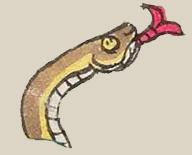coatl (Mdz34r)
This element for a snake or serpent (coatl) has been carved from the compound sign for the place name, Coatepec. It is a partial snake, largely consisting of the head and a curving upper body. It is shown in profile, somewhat upright, facing toward the viewer's right. The body is brown shading toward a yellow/white on the belly. The underbelly is segmented. The eye is open, and the bifurcated (red) tongue protrudes. The base of the tongue has perpendicular lines. The tongue is reminiscent of a flame.
Stephanie Wood
A wooden, turquoise-mosaic pectoral in the shape of a snake is held in the British Museum, whose curators have written: "The Mexica considered serpents to be powerful, multifaceted creatures that could bridge the spheres (the underworld, water and sky) owing to their physical and mythical characteristics." Besides being an animal that was common in the central highlands, the coatl is the name of the first day of a thirteen-day calendrical cycle.
Stephanie Wood
Stephanie Wood
c. 1541, but by 1553 at the latest
Stephanie Wood
víboras, serpientes, culebras, cohuatl

coa(tl), snake or serpent, https://nahuatl.wired-humanities.org/content/coatl
snake or serpent
el serpiente
Stephanie Wood
Codex Mendoza, folio 34 recto, https://digital.bodleian.ox.ac.uk/objects/2fea788e-2aa2-4f08-b6d9-648c00..., image 78 of 188.
The Bodleian Libraries, University of Oxford, hold the original manuscript, the MS. Arch. Selden. A. 1. This image is published here under the UK Creative Commons, “Attribution-NonCommercial-ShareAlike 3.0 License” (CC-BY-NC-SA 3.0).

